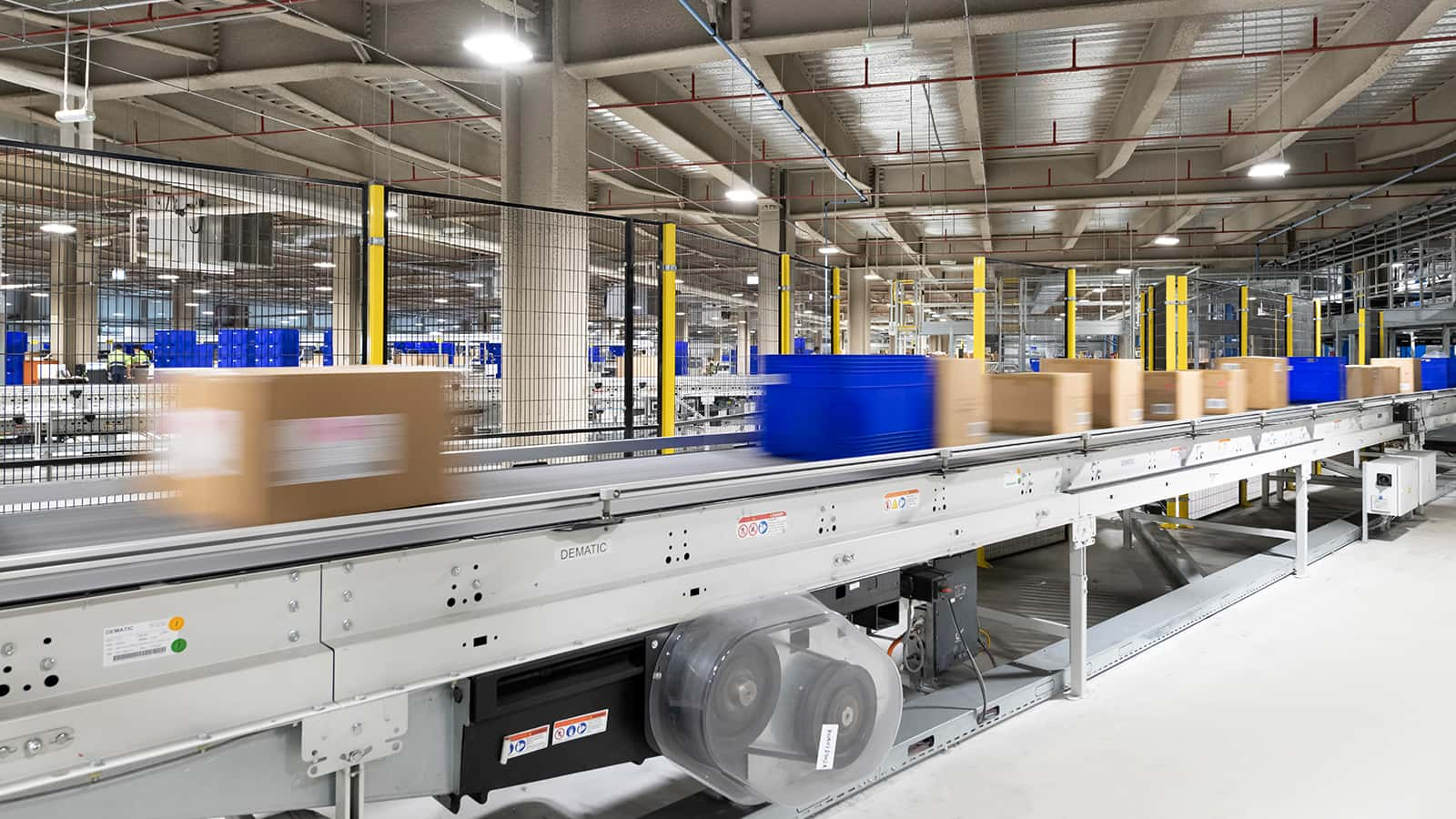Conveyor systems support order picking and kitting processes by synchronizing the material flow between and among the functional areas of the production and distribution operation. Conveyor systems can effectively transport order containers to warehouse zones for picking, enable efficient case picking, connect goods-to-person workstations with storage and provide inbound flow to storage from decanting workstations.
Piece pick with zone route conveyor network
Order fulfillment is optimized by conveying order containers only to warehouse zones with picks. The Zone Route system is a discrete order picking system used for distribution operations that need to pick, pack and ship customer orders with more productivity, accuracy and speed. The pre-engineered Zone Route process is based on a configuration that arranges the warehouse into picking zones. Each picking zone supports a specific SKU category, typically by velocity. The layout typically includes 4-16 picking zones. The system can accommodate the transport of inbound inventory for re-stocking.
The Zone Route split case pick system is engineered around a methodology that brings the order container to the worker. Workers remain in an assigned zone; efficiency is gained since workers do not roam the warehouse searching for picks, but instead are focused on picking a segment of the inventory located in a compact geography. In each zone, SKUs are staged on flow rack, shelving and pallets. The zones are slotted based on attributes such as family groups, velocity or cube utilization. The operational method is to route the order container only to the zones where there are picks.
To support the Zone Route System pick method, a conveyor network is provided to control the flow of order cartons into and out of the zones. One worker is stationed in each zone; however additional workers could be added during peak periods. Or, during periods of lower order volume, one worker could traverse multiple zones. The conveyor layout features an accumulation conveyor spine that travels through the entire split case pick module with an exit and a siding for each zone. Each exit point consists of a bar code scanner and a right angle transfer to divert the order container into the pick zone. When the picks are completed, the order container carton flows out on the central conveyor spine. If there are more picks, it moves to another zone(s); if no other picks, it travels directly to packing on the conveyor spine.
The conveyor network is also utilized to replenish inventory to each zone. Inventory for put away is conveyed to the appropriate zone for put away (see example of replenishment using the blue totes).
- Discrete, piece pick order fulfillment process
- Conveyor flow of order container to pick zones
- Order container travels only to zones with picks
- High density, compact pick zones = less walking
- Labor productivity & processing speed
- Improved order & inventory accuracy
- Modular design: re-configurable, expandable
- Scale up: multiple workers per zone
- Scale down: one worker for multiple zones
- Accommodates replenishment & returns
- Real time visibility, control & insight
- Low risk, proven performance, attractive ROI
Case picking to conveyor system
The “case pick to conveyor” method brings efficiency and accuracy to the order fulfillment process. Low, mid and high velocity stock keeping units are picked from pallet storage racking within the full case pick module. A combination of RF, voice and light directed picking may be used to pick full case SKUs and then place directly onto powered take-away conveyor. Typically, the conveyor network transports the cases to a palletizer (manual or automated). Cases can also be conveyed to a dock door for direct fluid loading onto a truck trailer.
The case pick module with the conveyor network requires constant replenishment of the pick face. The pick face consists of a pallet. Each pick face can be automatically replenished with an automated storage/retrieval sub-system. When the pick face is depleted, the storage/retrieval machine replenishes the pick face with a pallet of the appropriate inventory. Automatic replenishment offers operational value: real time software directed replenishment, high level of inventory accuracy, narrow replenishment aisle, and less warehouse labor for replenishment activity.
Goods-to-person case picking with conveyor systems
Pallets holding cases, stored in a pallet automated storage and retrieval system (ASRS), are conveyed to goods-to-person case picking workstations. An ergonomic lift at the workstation supports worker ergonomics for safe and comfortable case picking. The cases to be picked from the inventory pallet are positioned at the ideal height for transfer to the outbound order pallet. Cases for the order pallet are removed from the inventory pallet. The order pallet is dispatched to shipping via pallet conveyor. Inventory pallets with residual cases are returned to the AS/RS automatically by the pallet conveyor system.
Goods-to-person piece picking with conveyor systems
Totes of inventory, stored in a miniload or shuttle ASRS, are conveyed to goods-to-person order picking workstations. The ergonomic workstation supports productivity and ergonomic operation. Pieces (stock keeping units, parts, etc.) are removed from the inventory tote and transferred to the order container. When all the items in the order/kit are placed into the order container, the conveyor network transports it to the outbound operations. Residual pieces in the inventory tote are transported back to the ASRS.
Decanting with conveyor systems
At receiving, pallets are transferred to and stored in an automated storage and retrieval system (ASRS). When inventory is required, pallets containing cases are conveyed to a decant workstation. An operator removes the case(s) from the inventory pallet and transfers the contents of a case into a tote. The pallet with residual inventory is conveyed back to the ASRS and placed into storage.
The Dematic difference
Conveyor systems are the vital interlink between the functional areas of the operation. The system management strategy and integration with controls and software ensures operational excellence. The conveyor system management is key to supporting throughput, capacity and accuracy. Planning and optimization of the material flow using the Dematic integrated software platform is critical to consistent and predictable conveyor system performance.

